
|
It returns for the first time in 70 years. It brightened up to 3.7 mag in early April (Apr. 6, Jose Guilherme Aguiar). Now it is 6.7 mag (June 1, Marco Goiato). Fading rapidly. In the Northern Hemisphere, it is not observable now. It locates somewhat low in the Southern Hemisphere. But it will become high in winter.
Date(TT) R.A. (2000) Decl. Delta r Elong. m1 Best Time(A, h)
June 8 6 14.30 -23 12.2 1.549 1.170 49 6.9 18:25 ( 76, 22)
June 15 6 42.98 -27 30.5 1.564 1.259 53 7.3 18:25 ( 72, 24)
|

|
It returned for the first time in 68 years. Now it is 7.3 mag (June 2, Virgilio Gonano). It will fade out rapidly after this. It stays extremely low in the Northern Hemisphere. In the Southern Hemisphere, it is not observable now, but it will appear in August.
Date(TT) R.A. (2000) Decl. Delta r Elong. m1 Best Time(A, h)
June 8 6 41.29 39 13.6 2.049 1.223 26 7.3 18:25 (132,-10)
June 15 7 12.48 40 48.4 2.010 1.198 27 7.2 18:25 (133,-10)
|

|
It will approach to Sun down to 0.4 a.u. in late September, and it is expected to brighten up to 0 mag. Now it is 10.2 mag (June 6, Virgilio Gonano). It will brighten rapidly after this. It will be getting lower gradually after this, and it will be unobservable in July in the Northern Hemisphere, or in August in the Southern Hemisphere. But it will be observable again in September in the Southern Hemisphere. At the high light, in the Northern Hemisphere, it will be observable in good condition after the perihelion passage. In the Southern Hemisphere, it will be observable in the low sky before and after the perihelion passage. It is fainter than this ephemeris recently.
Date(TT) R.A. (2000) Decl. Delta r Elong. m1 Best Time(A, h)
June 8 11 48.69 2 53.9 1.832 2.227 98 9.3 18:40 (180, 52)
June 15 11 36.72 3 1.9 1.875 2.123 89 9.1 18:25 (170, 52)
|

|
The condition is bad in this apparition. It brightens up to 10 mag in early summer, however, it is not observable at all. It will fade out rapidly after this. It will never be observable after this.
Date(TT) R.A. (2000) Decl. Delta r Elong. m1 Best Time(A, h)
June 8 5 58.00 25 27.5 2.058 1.089 12 10.3 18:25 (115, -9)
June 15 6 30.02 26 4.0 2.082 1.115 12 10.4 18:25 (116, -9)
|

|
It brightened very rapidly. Now it is 10.8 mag (June 4, Carlos Labordena). It will fade out rapidly after this. It locates somewhat low in the Northern Hemisphere. In the Southern Hemisphere, it is not observable now, but it will appear in August.
Date(TT) R.A. (2000) Decl. Delta r Elong. m1 Best Time(A, h)
June 8 5 41.92 52 16.2 1.885 1.130 30 11.2 18:25 (138,-25)
June 15 6 24.34 55 41.7 1.848 1.150 33 11.3 18:25 (142,-25)
|

|
Now it is 12.9 mag (June 7, Ken-ichi Kadota). It will fade out rapidly after this. It locates somewhat low in the Northern Hemisphere. But it will become high in autumn. It stays extremely low in the Southern Hemisphere.
Date(TT) R.A. (2000) Decl. Delta r Elong. m1 Best Time(A, h)
June 8 2 44.47 24 27.7 2.317 1.554 32 11.4 5:32 (234, 7)
June 15 3 6.52 26 43.6 2.295 1.553 33 11.4 5:35 (231, 7)
|

|
First return of a new periodic comet which was discovered in 2011, half a year after the perihelion passage. It brightened very rapidly. Now it is 12.1 mag (May 30, Thomas Lehmann). It will fade out rapidly after this. It will be fainter than 18 mag in September. It stays extremely low in the Northern Hemisphere. In the Southern Hemisphere, it stays observable in good condition.
Date(TT) R.A. (2000) Decl. Delta r Elong. m1 Best Time(A, h)
June 8 11 13.10 -26 12.1 0.672 1.325 101 11.7 18:25 (154, 81)
June 15 11 46.11 -27 30.4 0.703 1.360 103 12.1 18:25 (158, 82)
|
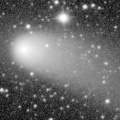
|
It brightened up to 9.6 mag from February to March (Feb. 25, Thomas Lehmann). Now it is 12.2 mag (June 5, Osamu Miyazaki). Fading gradually. In the Northern Hemisphere, it stays observable in good condition. In the Southern Hemisphere, it is not observable now, but it will appear in September.
Date(TT) R.A. (2000) Decl. Delta r Elong. m1 Best Time(A, h)
June 8 20 34.47 58 34.8 1.872 2.096 87 12.1 3:28 (180, -4)
June 15 20 30.15 60 12.6 1.930 2.168 89 12.3 2:56 (180, -5)
|
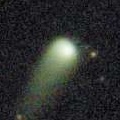
|
Now it is 12.8 mag (May 31, Hiroshi Abe). It stays 12 mag for a while. In the Northern Hemisphere, it will be unobservable soon. But it will be observable again in July. In the Southern Hemisphere, it is not observable now.
Date(TT) R.A. (2000) Decl. Delta r Elong. m1 Best Time(A, h)
June 8 6 56.52 35 6.6 4.645 3.770 27 12.7 18:25 (130, -5)
June 15 6 59.29 35 36.1 4.677 3.756 22 12.7 18:25 (127, -9)
|

|
It is expected to brighten up to 12.5 mag in summer. Now it is 14.0 mag (May 29, Chris Wyatt). It stays 13 mag for a while. In the Northern Hemisphere, it is not observable now, but it will appear in August. In the Southern Hemisphere, it stays observable in good condition. Around the high light, it is observable in good condition in the Southern Hemisphere, but it locates very low in the Northern Hemisphere.
Date(TT) R.A. (2000) Decl. Delta r Elong. m1 Best Time(A, h)
June 8 15 42.81 -76 0.3 2.246 2.957 125 13.5 22:35 ( 0, 49)
June 15 15 32.89 -74 36.7 2.195 2.913 126 13.4 21:57 ( 0, 50)
|
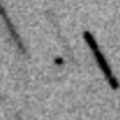
|
Brightening gradually. Now it is not observable. It will appear in September in the Northern Hemisphere. In the Southern Hemisphere, it will never be observable after this. It brightens up to 11 mag in August. But it is not observable around the high light.
Date(TT) R.A. (2000) Decl. Delta r Elong. m1 Best Time(A, h)
June 8 5 38.01 5 21.0 2.360 1.440 19 13.9 18:25 ( 95, -2)
June 15 6 0.40 5 47.5 2.278 1.355 18 13.6 18:25 ( 95, -3)
|

|
Now it is 13.7 mag (May 31, Hiroshi Abe). It stays 14 mag for a while. In the Northern Hemisphere, it will be unobservable in August. In the Southern Hemisphere, it stays observable in good condition.
Date(TT) R.A. (2000) Decl. Delta r Elong. m1 Best Time(A, h)
June 8 11 57.64 -24 54.2 4.585 5.034 110 13.8 18:49 (180, 80)
June 15 12 0.51 -23 57.6 4.669 5.026 104 13.9 18:25 (180, 79)
|

|
It was observed at 9-10 mag for a long time in 2023. Now it is 13.3 mag (May 20, Thomas Lehmann). Fading slowly. In the Northern Hemisphere, it will never be observable after this. In the Southern Hemisphere, it stays observable in good condition.
Date(TT) R.A. (2000) Decl. Delta r Elong. m1 Best Time(A, h)
June 8 0 39.49 -50 35.9 4.541 4.718 93 14.0 5:32 (315, 63)
June 15 0 40.01 -52 19.9 4.512 4.775 98 14.1 5:35 (324, 66)
|

|
Now it is 15.2 mag (May 17, ATLAS-MLO, Mauna Loa). It will be unobservable in July. But it will be observable again in September.
Date(TT) R.A. (2000) Decl. Delta r Elong. m1 Best Time(A, h)
June 8 8 28.91 19 8.5 6.848 6.207 47 14.1 18:25 (133, 21)
June 15 8 33.30 18 48.8 6.928 6.209 41 14.2 18:25 (129, 17)
|

|
Now it is 14.1 mag (June 3, Thomas Lehmann). Fading slowly. It stays extremely low in the Northern Hemisphere. In the Southern Hemisphere, it will be getting lower gradually. But it will be getting higher again after August.
Date(TT) R.A. (2000) Decl. Delta r Elong. m1 Best Time(A, h)
June 8 9 50.75 -24 50.6 2.764 2.844 84 14.5 18:25 (108, 66)
June 15 9 47.37 -23 58.0 2.911 2.868 77 14.6 18:25 (102, 59)
|

|
Now it is 14.5 mag (June 7, Ken-ichi Kadota). It stays 15 mag for a while. In the Northern Hemisphere, it will be getting higher gradually. In the Southern Hemisphere, it stays observable in good condition.
Date(TT) R.A. (2000) Decl. Delta r Elong. m1 Best Time(A, h)
June 8 0 51.35 -0 31.6 2.052 1.881 65 14.6 5:32 (229, 44)
June 15 1 5.00 0 44.5 2.009 1.897 68 14.6 5:35 (223, 45)
|
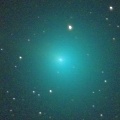
|
It brightened up to 8.9 mag from January to March (Feb. 13, Chris Wyatt). Now it is 13.2 mag (June 3, Thomas Lehmann). Fading rapidly. It will be fainter than 18 mag in August. It locates somewhat low in the Northern Hemisphere.
Date(TT) R.A. (2000) Decl. Delta r Elong. m1 Best Time(A, h)
June 8 9 59.39 8 36.7 2.099 2.023 71 14.6 18:25 (149, 41)
June 15 10 13.86 7 26.9 2.213 2.072 68 15.0 18:25 (144, 41)
|
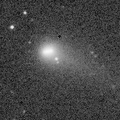
|
Now it is 14.7 mag (May 31, Hiroshi Abe). Fading slowly. It will be unobservable in July.
Date(TT) R.A. (2000) Decl. Delta r Elong. m1 Best Time(A, h)
June 8 7 43.04 28 29.5 2.806 2.071 35 14.7 18:25 (132, 7)
June 15 8 1.09 27 43.9 2.857 2.085 33 14.7 18:25 (130, 6)
|

|
Alan Hale reported its cometary appearance. Now it is 14.6 mag (June 2, Taras Prystavski). Fading gradually. It will be unobservable in July in the Northern Hemisphere, or in September in the Southern Hemisphere.
Date(TT) R.A. (2000) Decl. Delta r Elong. m1 Best Time(A, h)
June 8 8 20.58 18 13.1 2.140 1.607 45 14.8 18:25 (131, 20)
June 15 8 41.23 16 58.9 2.181 1.616 44 14.9 18:25 (129, 20)
|

|
It brightened up to 8 mag from 2022 summer to 2023 spring. Now it is 14.5 mag (Apr. 27, Hiroshi Abe). It stays 15 mag for a while. Now it is not observable. It will appear in July.
Date(TT) R.A. (2000) Decl. Delta r Elong. m1 Best Time(A, h)
June 8 5 44.73 14 33.2 6.966 5.979 12 15.0 18:25 (104, -6)
June 15 5 48.78 14 53.5 7.038 6.037 9 15.0 18:25 (101,-11)
|

|
Now it is 16.6 mag (May 30, Hidetaka Sato). Fading slowly. In the Northern Hemisphere, it is not observable now, but it will be observable soon. It stays extremely low in the Southern Hemisphere.
Date(TT) R.A. (2000) Decl. Delta r Elong. m1 Best Time(A, h)
June 8 2 50.69 6 17.9 2.165 1.476 36 15.3 5:32 (248, 18)
June 15 3 9.71 8 51.9 2.162 1.489 37 15.1 5:35 (244, 18)
|
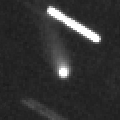
|
Now it is 16.1 mag (Feb. 22, ATLAS Chile). It stays 15 mag for a while. In the Northern Hemisphere, it is not observable now. In the Southern Hemisphere, it stays observable in good condition. The brightness evolution is slower than originally expected.
Date(TT) R.A. (2000) Decl. Delta r Elong. m1 Best Time(A, h)
June 8 4 7.01 -42 4.4 3.043 2.794 66 15.2 5:32 (304, 28)
June 15 4 23.24 -44 2.8 2.976 2.784 69 15.1 5:35 (305, 31)
|
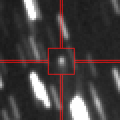
|
It brightened very rapidly in outburst in late May. Now it is 15.1 mag (May 28, ATLAS Chile). Fading slowly. It locates somewhat low in the Northern Hemisphere. In the Southern Hemisphere, it stays observable in good condition.
Date(TT) R.A. (2000) Decl. Delta r Elong. m1 Best Time(A, h)
June 8 15 30.90 -26 27.3 2.197 3.163 158 15.2 22:22 (180, 81)
June 15 15 27.69 -25 49.2 2.237 3.165 151 15.3 21:51 (180, 81)
|

|
It brightened up to 8.3 mag in 2021-2022 winter (Jan. 6, 2022, Toshiyuki Takahashi). Now it is 16.3 mag (May 23, ATLAS South Africa). It stays 16 mag for a while. In the Northern Hemisphere, it will never be observable after this. In the Southern Hemisphere, it stays observable in good condition.
Date(TT) R.A. (2000) Decl. Delta r Elong. m1 Best Time(A, h)
June 8 10 40.23 -48 12.4 7.767 8.055 102 15.2 18:25 ( 32, 73)
June 15 10 42.63 -47 45.6 7.879 8.100 98 15.3 18:25 ( 43, 71)
|

|
It will brighten up to 14 mag from summer to autumn. Now it is 16.3 mag (June 5, Hirohisa Sato). Brightening slowly. It locates somewhat low in the Northern Hemisphere. In the Southern Hemisphere, it stays observable in good condition. Around the high light, it is observable in good condition in the Southern Hemisphere. But it locates extremely low in the Northern Hemisphere.
Date(TT) R.A. (2000) Decl. Delta r Elong. m1 Best Time(A, h)
June 8 12 27.78 -17 31.9 1.352 2.007 115 15.4 19:20 (180, 73)
June 15 12 31.81 -17 24.1 1.382 1.971 109 15.3 18:56 (180, 73)
|

|
Now it is 14.8 mag (May 19, ATLAS Chile). It stays 16 mag for a while. In the Northern Hemisphere, it is not observable now, but it will appear in September. In the Southern Hemisphere, it will be getting lower gradually. But it will be getting higher again after July.
Date(TT) R.A. (2000) Decl. Delta r Elong. m1 Best Time(A, h)
June 8 7 26.19 -32 12.6 5.604 5.249 64 15.3 18:25 ( 74, 39)
June 15 7 28.39 -32 1.1 5.695 5.290 61 15.4 18:25 ( 72, 34)
|

|
It will brighten up to 14.5 mag in summer. Now it is 16.5 mag (May 30, ATLAS South Africa). It stays 15 mag for a while. It locates somewhat low in the Northern Hemisphere. But it will become high in summer. In the Southern Hemisphere, it stays observable in good condition.
Date(TT) R.A. (2000) Decl. Delta r Elong. m1 Best Time(A, h)
June 8 1 13.78 -16 18.0 1.620 1.570 68 15.9 5:32 (251, 51)
June 15 1 34.82 -14 9.2 1.565 1.538 69 15.6 5:35 (247, 51)
|
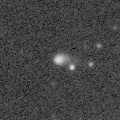
|
Now it is 15.9 mag (Mar. 26, ATLAS Chile). It stays 15 mag for a while. Now it is not observable. It will appear soon in the Southern Hemisphere, or in August in the Northern Hemisphere.
Date(TT) R.A. (2000) Decl. Delta r Elong. m1 Best Time(A, h)
June 8 5 26.70 1 49.8 7.347 6.414 21 15.6 18:25 ( 91, -2)
June 15 5 32.06 2 9.2 7.325 6.389 21 15.6 5:35 (272, -6)
|
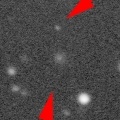
|
It is expected to brighten up to 13 mag in 2025 autumn, and it will be observable in good condition. Now it is 15.9 mag (May 24, Ken-ichi Kadota). Brightening slowly. It stays observable in good condition.
Date(TT) R.A. (2000) Decl. Delta r Elong. m1 Best Time(A, h)
June 8 22 58.12 -5 13.6 5.073 5.237 93 15.7 5:32 (190, 60)
June 15 23 0.39 -4 53.2 4.930 5.198 99 15.6 5:27 (180, 60)
|
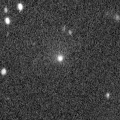
|
Very large comet. It is expected to brighten up to 13 mag in 2031. Now it is 15.0 mag (May 3, Thomas Lehmann). It stays 16 mag for a while. In the Northern Hemisphere, it is not observable now. In the Southern Hemisphere, it stays observable in good condition. In the Northern Hemisphere, it is not observable until 2030.
Date(TT) R.A. (2000) Decl. Delta r Elong. m1 Best Time(A, h)
June 8 3 45.72 -61 47.9 16.333 16.295 86 15.7 5:32 (325, 37)
June 15 3 49.74 -62 0.6 16.278 16.271 87 15.7 5:35 (325, 40)
|
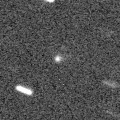
|
Now it is 16.3 mag (Mar. 29, Ken-ichi Kadota). It stays 16 mag for a while. Now it is not observable. It will appear in September in the Northern Hemisphere.
Date(TT) R.A. (2000) Decl. Delta r Elong. m1 Best Time(A, h)
June 8 5 50.99 21 15.5 2.909 1.921 10 16.0 18:25 (110, -8)
June 15 6 9.50 21 32.3 2.900 1.901 8 15.9 18:25 (109,-10)
|
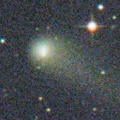
|
It brightened up to 11.1 mag in early 2022 (Mar. 31, 2022, F. Kugel, J.-G. Bosch, J. Nicolas). Now it is 15.9 mag (May 26, Ken-ichi Kadota). It stays 17 mag for a while. In the Northern Hemisphere, it stays observable in good condition. It locates somewhat low in the Southern Hemisphere.
Date(TT) R.A. (2000) Decl. Delta r Elong. m1 Best Time(A, h)
June 8 17 31.92 32 55.9 6.520 7.136 123 16.0 0:26 (180, 22)
June 15 17 28.90 33 6.2 6.564 7.176 123 16.1 23:52 (180, 22)
|
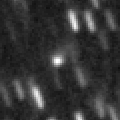
|
Now it is 16.5 mag (June 6, Giuseppe Pappa). It stays 16 mag for a while. In the Northern Hemisphere, it will be unobservable in July. In the Southern Hemisphere, it stays observable in good condition.
Date(TT) R.A. (2000) Decl. Delta r Elong. m1 Best Time(A, h)
June 8 14 20.08 -50 3.9 4.700 5.496 137 16.3 21:11 ( 0, 75)
June 15 14 8.73 -49 5.6 4.742 5.479 132 16.3 20:32 ( 0, 76)
|

|
It brightened up to 12.1 mag in 2023 spring (May 20, 2023, Jose Guilherme de S. Aguiar). Now it is 15.4 mag (May 30, Thomas Lehmann). It stays 17 mag for a while. In the Northern Hemisphere, it is not observable now, but it will appear in September.
Date(TT) R.A. (2000) Decl. Delta r Elong. m1 Best Time(A, h)
June 8 5 52.38 -38 15.3 5.202 4.811 62 16.3 18:25 ( 59, 24)
June 15 5 59.26 -37 30.6 5.267 4.858 61 16.4 18:25 ( 58, 20)
|
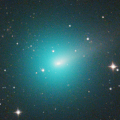
|
It brightened up to 7.4 mag from December to January (Dec. 24, Osamu Miyazaki). Now it is 16.3 mag (May 29, Ken-ichi Kadota). Fading rapidly. It will be fainter than 18 mag in July. In the Northern Hemisphere, it will be getting lower gradually. In the Southern Hemisphere, it stays observable in good condition.
Date(TT) R.A. (2000) Decl. Delta r Elong. m1 Best Time(A, h)
June 8 12 28.10 1 4.0 1.652 2.197 108 16.4 19:20 (180, 54)
June 15 12 34.73 -0 2.0 1.778 2.249 103 16.9 18:59 (180, 55)
|

|
It will brighten up to 16 mag in summer. Now it is 16.8 mag (May 29, ATLAS South Africa). It stays 17 mag for a while. In the Southern Hemisphere, it stays observable in good condition.
Date(TT) R.A. (2000) Decl. Delta r Elong. m1 Best Time(A, h)
June 8 23 24.25 -18 52.7 1.995 2.286 93 16.7 5:32 (215, 71)
June 15 23 32.56 -18 30.8 1.932 2.298 97 16.6 5:35 (199, 73)
|

|
Now it is 16.4 mag (May 26, ATLAS South Africa). It stays 17 mag for a while. In the Northern Hemisphere, it will be getting lower gradually after this, and it will be unobservable in September. In the Southern Hemisphere, it stays observable in good condition.
Date(TT) R.A. (2000) Decl. Delta r Elong. m1 Best Time(A, h)
June 8 12 32.60 3 52.5 2.954 3.414 108 16.7 19:24 (180, 51)
June 15 12 33.98 3 19.7 3.033 3.399 102 16.7 18:58 (180, 52)
|
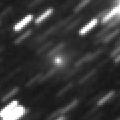
|
Very far object. Now it is 17.1 mag (Apr. 2, ATLAS Chile). It stays 17 mag for a while. In the Northern Hemisphere, it is not observable now. In the Southern Hemisphere, it stays observable in good condition.
Date(TT) R.A. (2000) Decl. Delta r Elong. m1 Best Time(A, h)
June 8 2 55.24 -63 15.1 10.325 10.371 89 16.7 5:32 (327, 42)
June 15 2 57.67 -63 26.2 10.290 10.376 92 16.7 5:35 (328, 45)
|
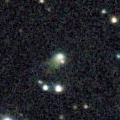
|
It brightened up to 14.5 mag from February to March (Mar. 11, W. Pei). Now it is 16.7 mag (June 3, ATLAS-HKO, Haleakala). It will fade out rapidly after this. It will be fainter than 18 mag in July. In the Northern Hemisphere, it will be getting lower gradually. In the Southern Hemisphere, it stays observable in good condition.
Date(TT) R.A. (2000) Decl. Delta r Elong. m1 Best Time(A, h)
June 8 10 47.64 11 23.2 1.697 1.847 81 16.7 18:25 (165, 43)
June 15 11 1.89 9 23.0 1.786 1.878 78 16.9 18:25 (160, 44)
|

|
It was observed at three apparitions in 2003, 2012 and 2016. It has not been observed yet in this apparition. It will brighten up to 15.5 mag in July. It brightens up to 15.5 mag, but it will turn to fade out rapidly after that. It will be fainter than 18 mag in July. It will be unobservable soon in the Northern Hemisphere, or in July in the Southern Hemisphere.
Date(TT) R.A. (2000) Decl. Delta r Elong. m1 Best Time(A, h)
June 8 2 8.60 15 57.9 1.113 0.769 42 17.9 5:32 (233, 19)
June 15 2 58.23 17 55.9 1.150 0.695 36 16.8 5:35 (235, 14)
|

|
It brightened up to 14 mag in early 2023 and 2023 autumn. Now it is 16.7 mag (May 25, ATLAS-MLO, Mauna Loa). It stays 17 mag for a while. It stays observable in good condition.
Date(TT) R.A. (2000) Decl. Delta r Elong. m1 Best Time(A, h)
June 8 22 34.72 19 55.3 4.654 4.746 88 16.9 5:29 (180, 35)
June 15 22 29.59 20 38.4 4.581 4.790 95 16.9 4:56 (180, 34)
|

|
Now it is 16.3 mag (May 24, ATLAS-MLO, Mauna Loa). It will fade out rapidly after this. It will be fainter than 18 mag in July. It stays observable in good condition.
Date(TT) R.A. (2000) Decl. Delta r Elong. m1 Best Time(A, h)
June 8 21 44.28 -3 17.6 1.147 1.772 109 16.9 4:38 (180, 58)
June 15 21 48.96 -3 11.7 1.119 1.805 115 17.2 4:15 (180, 58)
|

|
Now it is 16.4 mag (May 4, Toshiyuki Takahashi). It stays 17 mag for a while. It stays observable in good condition.
Date(TT) R.A. (2000) Decl. Delta r Elong. m1 Best Time(A, h)
June 8 15 3.89 -1 9.1 1.995 2.875 143 16.9 21:55 (180, 56)
June 15 15 1.84 -0 57.6 2.046 2.872 136 16.9 21:25 (180, 56)
|

|
Now it is 16.8 mag (May 18, ATLAS South Africa). It stays 17 mag for a while. In the Northern Hemisphere, it is not observable now. In the Southern Hemisphere, it will be getting lower gradually after this, and it will be unobservable in August. But it will be observable again in September.
Date(TT) R.A. (2000) Decl. Delta r Elong. m1 Best Time(A, h)
June 8 8 28.75 -5 33.8 4.572 4.113 57 17.1 18:25 (114, 39)
June 15 8 36.00 -5 44.1 4.612 4.082 53 17.1 18:25 (110, 35)
|

|
Now it is 17.1 mag (May 27, ATLAS Chile). It stays 17 mag for a while. In the Northern Hemisphere, it is not observable now, but it will appear in September. It locates somewhat low in the Southern Hemisphere. But it will become high in autumn. It stays 15 mag for a long time from late 2024 to early 2026.
Date(TT) R.A. (2000) Decl. Delta r Elong. m1 Best Time(A, h)
June 8 6 47.75 -32 35.6 5.422 5.002 60 17.2 18:25 ( 70, 32)
June 15 6 53.67 -31 31.5 5.429 4.966 58 17.1 18:25 ( 69, 27)
|

|
Now it is 17.0 mag (May 29, A. Diepvens). It stays 17 mag for a while. It will be getting lower gradually after this, and it will be unobservable in August. But it will be observable again in September in the Northern Hemisphere.
Date(TT) R.A. (2000) Decl. Delta r Elong. m1 Best Time(A, h)
June 8 10 11.63 19 23.4 5.585 5.337 70 17.1 18:25 (157, 32)
June 15 10 13.56 19 45.7 5.664 5.305 64 17.1 18:25 (151, 30)
|
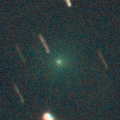
|
First return of a new periodic comet which brightened up to 10 mag in 2001. It brightened up to 12.5 mag from February to March (Feb. 29, Thomas Lehmann). Now it is 14.9 mag (May 28, Thomas Lehmann). Fading rapidly. It will be fainter than 18 mag soon. It locates somewhat low in the Northern Hemisphere. In the Southern Hemisphere, it will never be observable after this.
Date(TT) R.A. (2000) Decl. Delta r Elong. m1 Best Time(A, h)
June 8 8 30.86 60 14.0 2.375 1.916 51 17.2 18:25 (159,-12)
June 15 9 3.96 57 34.2 2.454 1.973 50 17.6 18:25 (158, -9)
|

|
Now it is 16.9 mag (May 28, ATLAS Chile). Fading slowly. It will be fainter than 18 mag in August. In the Southern Hemisphere, it stays observable in good condition.
Date(TT) R.A. (2000) Decl. Delta r Elong. m1 Best Time(A, h)
June 8 14 1.20 -18 39.9 2.786 3.596 136 17.2 20:53 (180, 74)
June 15 14 2.46 -17 54.7 2.872 3.614 130 17.3 20:26 (180, 73)
|

|
It approaches to Sun down to 0.09 a.u. on Jan. 13, 2025. According to the calculation, it will brighten up to -1 mag. But probably, it will be disintegrated. At the high light, it may be observable after the perihelion passage only in the Southern Hemisphere. Now it is 17.2 mag (May 31, ATLAS South Africa). Brightening gradually. In the Northern Hemisphere, it will never be observable after this. In the Southern Hemisphere, it stays observable in good condition.
Date(TT) R.A. (2000) Decl. Delta r Elong. m1 Best Time(A, h)
June 8 13 55.13 -77 59.5 3.296 3.912 120 17.5 20:46 ( 0, 47)
June 15 13 29.27 -76 13.5 3.225 3.826 119 17.4 19:53 ( 0, 49)
|

|
Now it is 17.4 mag (June 6, ATLAS-HKO, Haleakala). It stays 18 mag for a while. In the Northern Hemisphere, it stays observable in good condition. It stays extremely low in the Southern Hemisphere.
Date(TT) R.A. (2000) Decl. Delta r Elong. m1 Best Time(A, h)
June 8 22 26.40 46 38.5 4.307 4.248 79 17.5 5:20 (180, 8)
June 15 22 17.80 47 27.9 4.225 4.257 84 17.4 4:44 (180, 7)
|

|
Now it is 19.2 mag (June 4, Yasukazu Ikari). Fading slowly. It will be fainter than 18 mag in July. It stays observable in good condition.
Date(TT) R.A. (2000) Decl. Delta r Elong. m1 Best Time(A, h)
June 8 18 53.93 -6 11.7 2.300 3.213 148 17.9 1:49 (180, 61)
June 15 18 40.93 -8 27.7 2.245 3.210 158 17.8 1:09 (180, 63)
|

|
Now it is 17.7 mag (June 3, ATLAS Chile). It stays 18 mag for a while. It stays extremely low in the Northern Hemisphere. But it will become high in spring. In the Southern Hemisphere, it stays observable in good condition. It is expected to brighten up to 13 mag in 2026, and it will be observable in excellent condition in the Northern Hemisphere. In the Southern Hemisphere, it locates very low at the high light.
Date(TT) R.A. (2000) Decl. Delta r Elong. m1 Best Time(A, h)
June 8 19 15.10 -42 59.1 7.277 8.143 146 17.9 2:10 ( 0, 82)
June 15 19 10.85 -42 55.0 7.188 8.099 152 17.9 1:38 ( 0, 82)
|

|
It has not been observed yet in this apparition. It stays 18 mag for a while. In the Northern Hemisphere, it will be getting higher gradually.
Date(TT) R.A. (2000) Decl. Delta r Elong. m1 Best Time(A, h)
June 8 0 55.90 8 2.9 2.198 1.930 61 18.1 5:32 (224, 36)
June 15 1 9.61 10 26.1 2.128 1.916 64 17.9 5:35 (218, 36)
|
|
![]()
 479P/2023 WM26 ( Elenin )
479P/2023 WM26 ( Elenin ) C/2021 S3 ( PanSTARRS )
C/2021 S3 ( PanSTARRS ) C/2022 E2 ( ATLAS )
C/2022 E2 ( ATLAS ) C/2023 C2 ( ATLAS )
C/2023 C2 ( ATLAS ) C/2023 R2 ( PanSTARRS )
C/2023 R2 ( PanSTARRS ) C/2021 G2 ( ATLAS )
C/2021 G2 ( ATLAS ) C/2020 V2 ( ZTF )
C/2020 V2 ( ZTF ) 29P/Schwassmann-Wachmann 1
29P/Schwassmann-Wachmann 1 C/2022 L2 ( ATLAS )
C/2022 L2 ( ATLAS ) 130P/McNaught-Hughes
130P/McNaught-Hughes 144P/Kushida
144P/Kushida 32P/Comas Sola
32P/Comas Sola P/2024 FG9 ( Nanshan-Hahn )
P/2024 FG9 ( Nanshan-Hahn ) C/2017 K2 ( PanSTARRS )
C/2017 K2 ( PanSTARRS ) 192P/Shoemaker-Levy 1
192P/Shoemaker-Levy 1 C/2022 S4 ( Lemmon )
C/2022 S4 ( Lemmon ) 299P/Catalina-PanSTARRS
299P/Catalina-PanSTARRS C/2019 L3 ( ATLAS )
C/2019 L3 ( ATLAS ) 37P/Forbes
37P/Forbes C/2019 U5 ( PanSTARRS )
C/2019 U5 ( PanSTARRS ) 146P/Shoemaker-LINEAR
146P/Shoemaker-LINEAR C/2022 QE78 ( ATLAS )
C/2022 QE78 ( ATLAS ) C/2022 N2 ( PanSTARRS )
C/2022 N2 ( PanSTARRS ) C/2014 UN271 ( Bernardinelli-Bernstein )
C/2014 UN271 ( Bernardinelli-Bernstein ) 30P/Reinmuth 1
30P/Reinmuth 1 C/2019 T4 ( ATLAS )
C/2019 T4 ( ATLAS ) C/2023 F3 ( ATLAS )
C/2023 F3 ( ATLAS ) C/2020 K1 ( PanSTARRS )
C/2020 K1 ( PanSTARRS ) 62P/Tsuchinshan 1
62P/Tsuchinshan 1 89P/Russell 2
89P/Russell 2 65P/Gunn
65P/Gunn C/2019 E3 ( ATLAS )
C/2019 E3 ( ATLAS ) 227P/Catalina-LINEAR
227P/Catalina-LINEAR P/2003 T12 ( SOHO )
P/2003 T12 ( SOHO ) C/2021 X1 ( Maury-Attard )
C/2021 X1 ( Maury-Attard ) 125P/Spacewatch
125P/Spacewatch 362P/(457175) 2008 GO98
362P/(457175) 2008 GO98 C/2023 T3 ( Fuls )
C/2023 T3 ( Fuls ) C/2024 A1 ( ATLAS )
C/2024 A1 ( ATLAS ) C/2023 H5 ( Lemmon )
C/2023 H5 ( Lemmon ) 473P/2023 W1 ( NEAT )
473P/2023 W1 ( NEAT ) C/2022 T1 ( Lemmon )
C/2022 T1 ( Lemmon ) C/2024 G3 ( ATLAS )
C/2024 G3 ( ATLAS ) C/2022 U1 ( Leonard )
C/2022 U1 ( Leonard ) C/2023 Q2 ( PanSTARRS )
C/2023 Q2 ( PanSTARRS ) C/2024 J3 ( ATLAS )
C/2024 J3 ( ATLAS ) 328P/LONEOS-Tucker
328P/LONEOS-Tucker![]()














































